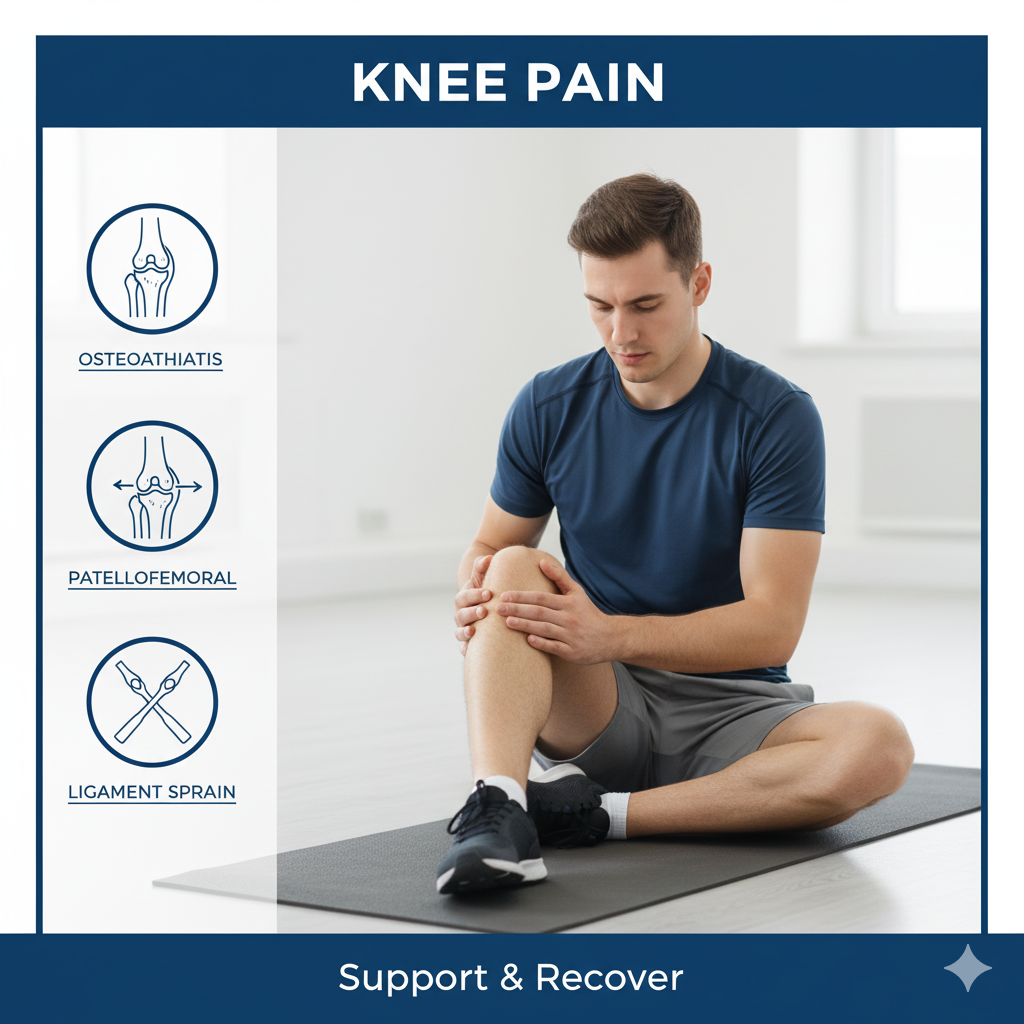Knee Pain Management: Complete Exercise & Treatment Guide

Knee pain affects over 25% of adults and is a leading cause of disability. Whether you're an athlete dealing with runner's knee, someone with arthritis, or recovering from an injury, proper exercise and management strategies can significantly improve your quality of life.
Understanding Common Knee Pain Causes
- Patellofemoral Pain Syndrome (Runner's Knee): Pain around or behind the kneecap
- Osteoarthritis: Degenerative joint disease causing stiffness and pain
- Meniscus Tears: Damage to the cartilage cushions in the knee
- Ligament Injuries: ACL, MCL, or PCL sprains or tears
- Patellar Tendinitis: Inflammation of the tendon connecting kneecap to shinbone
- IT Band Syndrome: Outer knee pain from iliotibial band friction
- Bursitis: Inflammation of fluid-filled sacs around the joint
Essential Exercises for Knee Pain Relief
1. Quad Sets
Benefits: Strengthens quadriceps without stressing knee joint
How to perform:
- Sit or lie with leg extended
- Tighten thigh muscles, pressing knee toward floor
- Hold for 5-10 seconds
- Relax completely
- Repeat 10-15 times per leg
- Perform 3 times daily
2. Straight Leg Raises
Benefits: Builds quad strength crucial for knee stability
How to perform:
- Lie on back, one knee bent, one straight
- Tighten thigh of straight leg
- Lift leg 6-10 inches off ground
- Hold for 3-5 seconds
- Lower slowly
- Perform 10-15 reps, 2-3 sets per leg
3. Wall Squats
Benefits: Strengthens quads, glutes, and hamstrings safely
How to perform:
- Stand with back against wall
- Feet shoulder-width apart, 1-2 feet from wall
- Slide down until knees at 45-60 degrees
- Hold 10-30 seconds
- Slide back up
- Perform 5-10 repetitions
4. Hamstring Curls (Standing)
Benefits: Balances quad strength, protects knee joint
How to perform:
- Stand holding a chair for balance
- Bend one knee, bringing heel toward buttock
- Keep thighs aligned
- Hold 2-3 seconds at top
- Lower slowly
- Perform 10-15 reps per leg, 2-3 sets
5. Clamshells
Benefits: Strengthens hip abductors, reduces knee stress
How to perform:
- Lie on side, knees bent at 45 degrees
- Keep feet together
- Lift top knee while keeping feet touching
- Don't rotate pelvis
- Hold 2 seconds at top
- Perform 15-20 reps per side, 2-3 sets
6. Step-Ups
Benefits: Functional strength for daily activities
How to perform:
- Use a 4-6 inch step initially
- Step up with affected leg
- Bring other foot up
- Step down slowly, leading with same leg
- Keep knee aligned over toes
- Perform 10-12 reps per leg, 2 sets
7. IT Band Stretch
Benefits: Reduces lateral knee pain and IT band syndrome
How to perform:
- Stand with affected leg crossed behind other
- Lean away from affected side
- Raise arm overhead on affected side
- Feel stretch along outer thigh and hip
- Hold 30 seconds
- Repeat 3 times per side
8. Quad Stretch (Standing)
Benefits: Improves flexibility, reduces patellofemoral pain
How to perform:
- Stand holding support with one hand
- Bend opposite knee, grasping ankle
- Pull heel toward buttock
- Keep knees together
- Hold 30 seconds per leg
- Repeat 3 times each side
9. Calf Raises
Benefits: Strengthens lower leg, improves knee stability
How to perform:
- Stand with feet hip-width apart
- Hold onto support if needed
- Rise up onto toes
- Hold 2 seconds at top
- Lower slowly
- Perform 15-20 reps, 2-3 sets
10. Hip Flexor Stretch
Benefits: Relieves anterior knee pain from tight hip flexors
How to perform:
- Kneel on one knee (use padding)
- Place other foot forward, knee at 90 degrees
- Push hips forward gently
- Keep back straight
- Hold 30 seconds per side
- Repeat 2-3 times
Progressive Strengthening Program
- Quad sets (3x daily)
- Straight leg raises
- Gentle stretches
- Add wall squats and clamshells
- Increase repetitions
- Begin step-ups (low step)
- Progress all exercises
- Add resistance bands
- Increase step height
- Return to functional activities gradually
Pain Management Strategies
R.I.C.E. Protocol (First 48-72 Hours)
- Rest: Avoid activities that cause pain
- Ice: Apply 15-20 minutes every 2-3 hours
- Compression: Use elastic bandage (not too tight)
- Elevation: Keep knee above heart level when possible
Long-Term Management
- Weight management: Each pound lost reduces 4 pounds of knee stress
- Low-impact exercise: Swimming, cycling, elliptical
- Proper footwear: Supportive shoes with good cushioning
- Activity modification: Avoid deep squats and high-impact activities initially
- Heat therapy: For chronic stiffness (not acute injury)
Exercises to Avoid with Knee Pain
- Deep squats or lunges (below 90 degrees)
- Running on hard surfaces (initially)
- Jumping or plyometric exercises
- Leg extensions with heavy weight
- Activities causing sharp pain
When to See a Physiotherapist
Consult a healthcare professional if you experience:
- Pain persisting beyond 2 weeks of home treatment
- Significant swelling or warmth
- Knee giving out or feeling unstable
- Locking or catching sensations
- Inability to fully straighten or bend knee
- Pain during rest or at night
- Signs of infection (fever, redness, heat)
Nutrition for Knee Health
- Anti-inflammatory foods: Fatty fish, berries, leafy greens
- Vitamin D and calcium: For bone health
- Omega-3 fatty acids: Reduce inflammation
- Collagen protein: Supports cartilage health
- Hydration: Keeps cartilage lubricated
AI-Powered Knee Recovery Programs
PhysioPocket creates personalized rehabilitation plans based on your specific knee condition, pain level, and progress. Get expert guidance and track your recovery journey.
Download on Google Play Learn MoreConclusion
Effective knee pain management requires a combination of appropriate exercises, pain management strategies, and lifestyle modifications. Most knee pain improves significantly with conservative treatment. Be patient with your recovery, stay consistent with exercises, and progress gradually. Remember, stronger muscles around the knee joint provide better support and protection, reducing pain and preventing future injuries.
Last updated: January 2025 | Evidence-based physiotherapy guidance